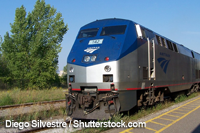AMTRAK
- FOR THE RAILROAD INDUSTRY PROFESSIONAL
Amtrak, California High Speed Rail Authority partner to buy new trainsWhen it comes to advancing true high-speed rail projects in the United States — trains that operate at top speeds of at least 150 mph, according to the Federal Railroad Administration — Amtrak's Northeast Corridor and the California High Speed Rail Authority's (CHSRA) proposed statewide system are the signature projects. Now,
 Amtrak is the United States' national intercity passenger-rail service provider. It was created under the Rail Passenger Service Act, which was signed by President Richard Nixon in 1970. The legislation enabled most freight railroads that operated intercity passenger-rail lines to join the national system and, in effect, abandon their unprofitable passenger service.
Amtrak is the United States' national intercity passenger-rail service provider. It was created under the Rail Passenger Service Act, which was signed by President Richard Nixon in 1970. The legislation enabled most freight railroads that operated intercity passenger-rail lines to join the national system and, in effect, abandon their unprofitable passenger service.The new, federally funded railroad launched service on May 1, 1971, under the name Amtrak, which is a combination of the words "America" and "track." Amtrak operated trains using the rolling stock and other equipment it inherited from the freight railroads' passenger operations.
In 1976, Congress passed the Railroad Revitalization and Regulatory Reform Act. The legislation's primary intent was to create Conrail, but it also gave Amtrak ownership of the Northeast Corridor between Washington, D.C., New York City and Boston. The railroad also received some capital dollars to rehabilitate the electrified corridor.
Amtrak spent several years upgrading the route between New York City and Washington, D.C., allowing the railroad in 1991 to begin operating Metroliner trains between New York and Washington, D.C., at speeds up to 125 mph. In the early 1990s, Amtrak launched the Northeast Corridor High Speed Rail Program in an effort to bring the New York-Boston segment of the corridor up to the same performance level. In 2000, Amtrak launched Acela Express high-speed rail service between Washington, D.C., New York City and Boston, with trains traveling at top speeds of 150 mph.
Through the years, Amtrak has faced much criticism in Congress. Members have called on Amtrak to become self sufficient and some have threatened to significantly cut or eliminate federal funding for the service.
Amtrak today
Amtrak currently serves more than 500 destinations in 46 states and three Canadian provinces, operating 300 trains along 21,200 route miles. Seventy-two percent of Amtrak's route miles are on tracks owned by host railroads. Amtrak pays the railroads for the use of their track and other resources required to operate passenger trains.
Amtrak operates 1,543 passenger cars, 484 locomotives, 80 Auto Train® vehicles and 80 baggage cars, and has placed orders for 130 new long-distance single-level cars and 70 electric locomotives. Amtrak also operates state-owned equipment totaling 136 passenger cars and 26 locomotives.
In addition, Amtrak operates commuter-rail services under contract for Maryland Rail Commuter (MARC), Connecticut's Shore Line East and southern California's Metrolink. Amtrak provides maintenance-of-way and dispatching services for the Massachusetts Bay Transportation Authority, equipment maintenance services for Seattle's Sound Transit and dispatching services for the South Florida Regional Transportation Authority's Tri-Rail.
In FY2012, Amtrak earned about $2.02 billion in ticket revenue. Annual ridership totaled more than 31.2 million passengers, the largest annual total in Amtrak's history and ninth annual ridership record in the past 10 years.
Amtrak has about 20,000 employees. The company is led by President and Chief Executive Officer Joseph Boardman. Board members include Chairman Thomas Carper, Vice Chairman Nancy Naples, U.S. Transportation Secretary Ray LaHood, Anthony Coscia, Bert DiClemente, Jeffrey Moreland, Christopher Beall and Yvonne Burke.

No comments:
Post a Comment